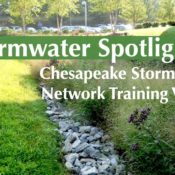Author: Ted Scott
Stormwater Spotlight: Chesapeake Stormwater Network Training Videos
Stormwater, or runoff from rainfall or snowmelt, is one of the coolest aspects of our landscapes. It’s dynamic, chaotic and supports stream systems, which are the lifeblood of the aquatic and terrestrial environments.
The fact that land has been (and is being) changed by humanity means that the natural flows and rhythms of nature have been interrupted and that significant natural forces must adjust to compensate. The art and science of stormwater management is about trying our best to help these significant natural forces adjust to what we are doing or have done to the land. This is done in the way that changes to the land surface are designed, how they are constructed, and how the drainage systems are maintained and repaired.
At Stormwater Maintenance & Consulting (SMC), we’re so excited about stormwater that it is what we devote ourselves to everyday. And I am pleased to share these three-video series on Stormwater BMP Maintenance that we’ve helped create with the nonprofit Chesapeake Stormwater Network to educate the public about Low Impact Development methods of stormwater management. The Chesapeake Stormwater Network worked with the Center for Watershed Protection to produce these videos with funding from the National Fish and Wildlife Foundation, Walmart, and the Keith Campbell Foundation.
#1 LID Stormwater Construction Practices
This first video is about proper construction techniques. In it, I talk about how a bioretention facility is supposed to work and about diagnosing what went wrong after a facility fails.
#2 Inspecting LID Stormwater Practices
In this second video, viewers will learn about the common problems inspectors find in bioretention facilities, bioswales and permeable pavement. Inspections can be done by contractors hired by a facility owner who would like to keep their facility in good working order, or by a municipality checking for functionality and compliance.
#3 Stormwater BMP & LID Maintenance
In this last video in this series, experts talk about how to properly maintain bioretention facilities and what common problems to look for. There are also some warnings about what can go wrong when maintenance is not done properly.
Be sure to share this wealth of knowledge with others through your favorite social media!
Ted Scott is the Vice President of Stormwater Maintenance, LLC, a firm that specializes in stormwater management infrastructure in the Mid-Atlantic region. This post was first spotted on the Sustainable Stormwater Management blog.
Lead image via Stormwater Maintenance, LLC




